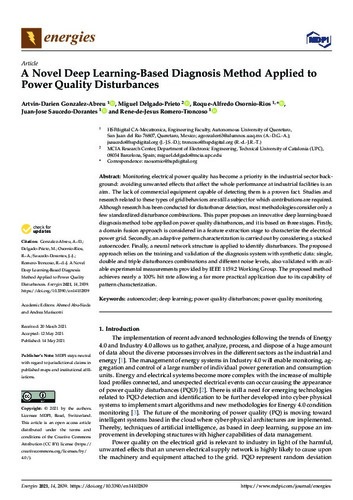A novel deep learning-based diagnosis method applied to power quality disturbances

Visualitza/Obre
Cita com:
hdl:2117/355836
Tipus de documentArticle
Data publicació2021-05-02
Condicions d'accésAccés obert
Llevat que s'hi indiqui el contrari, els
continguts d'aquesta obra estan subjectes a la llicència de Creative Commons
:
Reconeixement 3.0 Espanya
Abstract
Monitoring electrical power quality has become a priority in the industrial sector background: avoiding unwanted effects that affect the whole performance at industrial facilities is an aim. The lack of commercial equipment capable of detecting them is a proven fact. Studies and research related to these types of grid behaviors are still a subject for which contributions are required. Although research has been conducted for disturbance detection, most methodologies consider only a few standardized disturbance combinations. This paper proposes an innovative deep learning-based diagnosis method to be applied on power quality disturbances, and it is based on three stages. Firstly, a domain fusion approach is considered in a feature extraction stage to characterize the electrical power grid. Secondly, an adaptive pattern characterization is carried out by considering a stacked autoencoder. Finally, a neural network structure is applied to identify disturbances. The proposed approach relies on the training and validation of the diagnosis system with synthetic data: single, double and triple disturbances combinations and different noise levels, also validated with available experimental measurements provided by IEEE 1159.2 Working Group. The proposed method achieves nearly a 100% hit rate allowing a far more practical application due to its capability of pattern characterization.
CitacióGonzález, A.D. [et al.]. A novel deep learning-based diagnosis method applied to power quality disturbances. "Energies", 2 Maig 2021, vol. 14, núm. 10, p. 2839:1-2839:17.
ISSN1996-1073
Versió de l'editorhttps://www.mdpi.com/1996-1073/14/10/2839
| Fitxers | Descripció | Mida | Format | Visualitza |
|---|---|---|---|---|
| energies-14-02839-v2.pdf | 1,427Mb | Visualitza/Obre |


